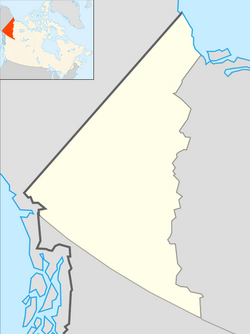| Mount Alverstone | |
|---|---|
 | |
| Highest point | |
| Elevation | 4420 m (14,500 ft) [1] NAVD88 |
| Prominence | 594 m (1950 ft) [1] |
| Parent peak | Mount Hubbard |
| Isolation | 3.62 km (2.25 mi) [1] |
| Listing | |
| Coordinates | 60°21′06″N139°04′31″W / 60.35167°N 139.07528°W [2] |
| Geography | |
| Location | Yakutat City and Borough, Alaska, U.S. / Yukon, Canada |
| Parent range | Saint Elias Mountains |
| Topo map(s) | USGS Mount Saint Elias B-3 NTS 115B6 Mount Alverstone |
| Climbing | |
| First ascent | 1951 by Walter Wood, Peter Wood, Robert Bates, Nicholas Clifford |
| Easiest route | glacier/snow/ice climb |
Mount Alverstone or Boundary Peak 180, is a high peak in the Saint Elias Mountains, on the border between Alaska and Yukon. It shares a large massif with the higher Mount Hubbard to the south and the slightly lower Mount Kennedy to the east. The summit of Mount Alverstone marks a sharp turn in the Alaska/Canada border; the border goes south from this point toward the Alaska panhandle and west toward Mount Saint Elias.
Contents
The mountain was named in 1908 for Lord Richard Everard Webster Alverstone, Lord Chief Justice of England, 1900–13, and U.S. Boundary Commissioner in 1903. He served on various arbitration commissions including the one dealing with the Bering Sea Fur seal controversy. In the Alaska boundary dispute in 1903, his vote was the deciding one against Canadian claims. [2]


